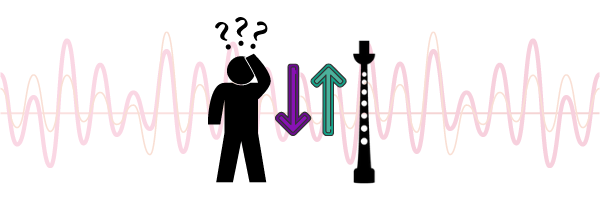Chanter Tuning Brain Games

Chanter tuning is a skill that can take a while to develop.
At Dojo U, we cover this regularly in live classes, in detail in our Transitioning to the Bagpipes and Instrument Fundamentals courses... and in a lot of detail, with dedicated 1:1 support, at our annual Tuning Workshop.
In a nutshell, there are many different ways you can tune a chanter, including:
- Moving the tape
- Raising or sinking the reed
- Licking the reed
- Adjusting a bridle on the reed
- Shaving the reed.
- Poking the reed
- Carving out a chanter hole.
Of course, some of these are far preferable to others, especially when some can damage your chanter reed or in extreme cases, they can also irreparably alter the (often very expensive) chanter.
In the heat of the moment, though, when you're stuck in a high-pressure situation – you just can't get that high G right and you have two minutes until you have to compete! – it can be challenging to remember the fundamentals of the graduated tuning effect, the complexities of how your current environment (temperature and humidity) and your bagpipe setup will affect your pitch, and which way you need to move that darned tape!
To help prepare you, we've compiled a few scenarios to help test your knowledge of chanter tuning.
So, when faced with the following situations, what is the best way to tune your chanter?
The answers are right at the bottom of the page – but no peeking! The idea here is to test yourself to get the right answer before you check whether your solution matches our recommendation.
Scenario 1: You already have a lot of tape on high hand notes, and you're fully warmed up, but your top hand (especially high G) is very sharp. What should you do?
Here's some thinking music for you as you ponder the answer...
Got it?! Scroll to the bottom of the page to see how you went (don't read on to the other answers if you can help it!).
Ready for another? Ok, here we go!
Scenario 2: You're fully warmed up, and Low A is in tune, but many of your other notes seem 'off'. What should you do?
Here's that thinking music again for you as you work through the answer...
Got it?! Scroll to the bottom of the page to see how you went (don't read on to the other answers if you can help it)!
Ready for another? Ok, here we go!
Scenario 3: You sounded great yesterday, but today you've played for a few minutes, and man, the High G is SHARP! What should you do?
Here's that thinking music again for you as you work through the answer...
Got it?! Scroll to the bottom of the page to see how you went (don't read on to the other answers if you can help it)!
Ready for another? Ok, here we go!
Scenario 4: You're fully warmed up, and you have very little tape on any of the notes (including High G). However, High G is flat relative to all of the other notes. What should you do?
Here's that thinking music a final time for you as you work through the answer...
Got it?! Scroll down to see how you went (don't read on to the other answers if you can help it)!

Answers
Remember, no cheating by peeking here before you work through how you'd solve this on your own... the only person who loses will be you, by cheating yourself out of the practice of thinking through to the answer on your own!
However, when you've worked through to find your answers, see if what you came up with matches what we suggest below. We've deliberately left some spaces in between to remove the temptation to read ahead!
Scenario 1: The best thing to do in this scenario is to raise the reed. Due to the graduated tuning effect, this will balance out the tuning of bottom hand vs. top hand notes, and allow you to bring your high G and the rest of the top hand into balance with the bottom hand.
Scenario 2: This is a common problem! Believe it or not, Low A is a note that changes more than most other notes as you warm up, or as environmental conditions change. Here's what to do:
- Test some of the other common notes using the blow trick.
- Are they flat or sharp to the drones?
- Adjust the drones to be in tune with the other notes (or the majority of the other notes).
- Then, adjust the tape on the Low A to bring it into tune with the rest of the chanter.
- Be careful though! This will be a moot procedure if you're not fully warmed up yet.
Scenario 3: You're probably not fully warmed up yet, and/or your bagpipe hasn't acclimatized to the environment you're in. Remember, as we play, moisture will work its way into your reed. This process happens the same way every time you play, and you can get to know how long you can expect to have to play before things "settle."
We recommend a "soak" period for each practice session to help stabilize the reeds. Play for 10 minutes, let the pipes rest for 10 minutes. THEN go about tweaking any notes you need to. Although, if you do this process routinely – guess what? You won't need to tune much any more at all!
Scenario 4: This is actually pretty rare, and probably wouldn't happen. But, what if it did?
There's a couple of possibilities. It would be tempting to sink the reed to make the high hand sharper relative to the bottom hand (subsequently you'd need to apply tape to High A, F, etc though so this isn't really the best option).
I think I would leave the reed where it is in the reed seat, and tape all of the other notes (especially the bottom hand notes). Having tape to move on the bottom notes is essential to having flexibility in the future. Minimizing tape on the high hand, while having room to move tape on the bottom is the ideal chanter setup.
What to do:
- Put some tape on the Low A, and re-tune your drones to that pitch.
- Continue to tweak the Low A tape until both the Low A and the High G are in tune.
- Next, start to tape other notes to bring them in tune with our new "setting".
Next steps:
For Dojo Members, check out our Transitioning to the Bagpipes and Instrument Fundamentals courses, or our classes library for some great past classes on this topic.
Not a Dojo U Member yet? Where have you been? We'd love to welcome you to our global community of lifelong piping learners – learn more about how to join today!






Raise the reed.
Add a rubber band
Raise the reed
I think, to simply raise the reed (adding hemp) will fix this issue.
Raise the reed
Raise the Reed.
Definately raise the reed
Try a new reed or more hemp on the reed
Open the reed mouth,with a mandrel , carefully scrape tip of reed on both sides
I agree that raising the eed is the most expedient thing to do, especially if you're about to perform and time is of the essence.
I would remove the tape off the high hand notes, raise the reed and play while listening how the high hand notes compare to the low hand notes. Tape notes as needed. If the high G is always too sharp needing too much tape then change the reed.
I agree raising the reed adding hemp if nessisary, at least Moistening and "fluffing the hemp up"
Poke with a mandril and lick the reed.
You may need to add some more hemp to raise the reed.
shave the reed in the area for the top hand
Try another reed.
The simplest?--raise the reed and see how that works; might need to remove some of that tape...if you're already warmed up, the reed should be moist enough (especially if you've kept it at optimum condition with a Piper's Pal reed cover...)
Same as Ray Spengler
Raise the reed.
Raise the reed and adjust the tape on the top hand
Raise the reed then if high g is still sharp beyond adding tape shave a 2 mm strip across the width of the reed 2 mm down from the mouth
I have put a thread into the reed seat on the chanter with a tap and die set.It helps to hold the reed very securely.BUT it needs to be done gently.
lift the reed in it's seat.
add hemp
raise the reed
When one note is the culprit I've found that cleaning the chanter holes and reed the best chance for success. Reverse blow through both first.
If you are using that much tape, either the reed has not been well set to start with or it is a bad reed. You could try raising it. If that does not work then bin it.
remove tape and raise the reed out of hole. If reed is lose after being raised, add hemp and try again.
Remove tape then raise reed. If still sharp shave reed. if still sharp Replace reed with a stronger one
Raise reed but I hate tape, so I would try to remove some at the first opportunity.
raise the reed first.
Raise the reed in the reed seat.
got it right, raise the reed.
raise the reed
Start by raising the reed, you may need to add hemp to the reed and re-tape the upper notes
Raise reed
Raise the reed
1. Raise the reed, if not working take the tape off and recheck and adjust as necessary. 2. New reed but that would be hard if not impossible in the middle of a practice or competition.
Raising the reed usually works for me
Interesting quiz. I wasn't sure what was meant by "off".